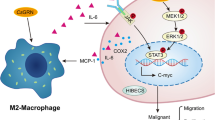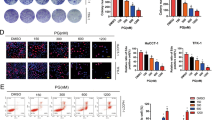Abstract
Infection by Clonorchis sinensis, the Chinese or oriental liver fluke, is a significant risk factor for the development of cholangiocarcinoma, a human epithelial carcinoma of the intrahepatic bile duct. Parthenolide is a sesquiterpene lactone that has strong anticancer properties and is also known to induce apoptosis in cholangiocarcinoma cells. Many investigators have reported that excretory–secretory (ES) products of C. sinensis as well as Opisthorchis viverrini promote the development of cholangiocarcinomas. However, the intrinsic mechanism is not clearly understood. Therefore, we investigated the biological roles of the ES products in a cholangiocarcinoma cell line, HuCCT1. The ES products of C. sinensis increased proliferation of HuCCT1 cells and augmented the expression of cyclooxygenase (COX)-2. To determine whether cells treated with ES products would respond differently to parthenolide, HuCCT1 cells were treated with parthenolide alone or parthenolide after pretreatment with ES products. Cells pretreated with ES products were resistant to parthenolide-induced apoptosis. Because parthenolide has been reported to be a COX-2 inhibitor, we hypothesize that COX-2 might be a key factor that promotes resistance of cholangiocarcinoma cancer cells to parthenolide-induced apoptosis. These results suggest that chemotherapy treatment regimens in cholangiocarcinoma patients with C. sinensis infection should be modulated to account for ES products excreted by the liver fluke.





Similar content being viewed by others
References
Bork PM, Schmitz ML, Kuhnt M, Escher C, Heinrich M (1997) Sesquiterpene lactone containing Mexican Indian medicinal plants and pure sesquiterpene lactones as potent inhibitors of transcription factor NF-κB. FEBS Lett 402:85–90
Chariyalertsak S, Sirikulchayanonta V, Mayer D, Kopp-Schneider A, Furstenberger G, Marks F, Muller-Decker K (2001) Aberrant cyclooxygenase isozyme expression in human intrahepatic cholangiocarcinoma. Gut 48:80–86
Choi MH, Ryu JS, Lee M, Li S, Chung BS, Chai JY, Sithithaworn P, Tesana S, Hong ST (2003) Specific and common antigens of Clonorchis sinensis and Opisthorchis viverrini (Opisthorchidae, Trematoda). Korean J Parasitol 41:155–163
Choi MS, Choi DI, Choi MH, Ji Z, Li Z, Cho SY, Hong KS, Lim HJ, Hong ST (2005) Correlation between sonographic findings and infection intensity in clonorchiasis. Am J Trop Med Hyg 73:1139–1144
Davis JN, McCabe MT, Hayward SW, Park JM, Day ML (2005) Disruption of Rb/E2F pathway results in increased cyclooxygenase-2 expression and activity in prostate epithelial cells. Cancer Res 65:3633–3642
Duffy MJ, Crown J (2008) A personalized approach to cancer treatment: how biomarkers an help. Clin Chem 54:1770–1779. doi:10.1373/clinchem.2008.110056
Endo K, Yoon BI, Pairokul C, Demetirs AJ, Sirica AE (2002) ERBB-2 overexpression and cyclooxygenase-2 up-regulation in human cholangiocarcinoma and risk conditions. Hepatology 36:439–450
Gores GJ (2003) Cholangiocarcinoma: current concepts and insights. Hepatology 37:961–969
Han C, Leng J, Demetris AJ, Wu T (2004) Cyclooxygenase-2 promotes human cholangiocarcinoma growth: evidence for cyclooxgenase-2 independent mechanism in celecoxib-mediated induction of p21waf/cip1 and p27kip1 and cell cycle arrest. Cancer Res 64:1369–1376
Hayashi N, Yamamoto H, Hiraoka N, Dono K, Ito Y, Okami J, Kondo M, Nagano H, Umeshita K, Sakon M, Matsuura N, Nakamori S, Monden M (2001) Differential expression of cycloxygenase-2 (COX-2) in human bile duct epithelial cells and bile duct neoplasm. Hepatology 34:638–650
Hehner SP, Heinrich M, Bork PM, Vogt M, Ratter F, Lehmann V, Schulze-Osthoff K, Dröge W, Schmitz ML (1998) Sesquiterpene lactones specifically inhibit activation of NF-κB by preventing the degradation of IκB- and IκB-α. J Biol Chem 273:1288–1297
Hong ST (2003) Clonorchis sinensis. In: Miliotis MD, Bier JW (eds) International handbook of food borne pathogens. Marcel Dekker, New York, pp 581–592
Hwang D, Fischer NH, Jang BC, Tak H, Kim JK, Lee W (1996) Inhibition of the expression of inducible cyclooxygenase and proinflammatory cytokines by sesquiterpene lactones in macrophages correlates with the inhibition of MAP kinases. Biochem Biophys Res Commun 226:810–818
International Agency for Research on Cancer (IARC) (1993) Monographs on the evaluation of carcinogenic risks to humans, vol. 61: schistosomes, liver flukes and Helicobacter pylori. International Agency for Research on Cancer (IARC) Press, Lyon
Johnson ES, Kadam NP, Hylands DM, Hylands PJ (1985) Efficacy of feverfew as prophylactic treatment of migraine. Bri Med J (Clin Res Ed) 291:569–573
Keiser J, Utzinger J (2005) Emerging food borne trematodiasis. Emerg Infect Dis 11:1507–1514
Kim HJ, Lee KT, Kim EK, Sohn TS, Heo JS, Choi SH, Choi DI, Lee JK, Paik SW, Rhee JC (2003) Expression of cyclooxygenase-2 in cholangiocarcinoma: correlation with clinicopathological feature and prognosis. J Gastroenterol Hepatol 19:582–588
Kim JH, Liu L, Lee SO, Kim YT, You KR, Kim DG (2005) Susceptibility of cholangiocarcinoma cells to parthenolide-induced apoptosis. Cancer Res 65:6312–6320
Kim YJ, Choi MH, Hong ST, Bae YM (2008a) Proliferative effects of excretory/secretory products from Clonorchis sinensis on the human epithelial cell line HEK293 via regulation of the transcription factor E2F1. Parasitol Res 102:411–417
Kim EM, Kim JS, Choi MH, Hong ST, Bae YM (2008b) Effects of excretory/secretory products from Clonorchis sinensis and the carcinogen dimethylnitrosamine on the proliferation and cell cycle modulation of human epithelial HEK293T cells. Korean J Parasitol 46:127–132
Knight DW (1995) Feverfew: chemistry and biological activity. Nat Prod Rep 12:271–276
Kuo YC, Kuo PL, Hsu YL, Cho CY, Lin CC (2006) Ellipticine induces apoptosis through p53-dependent pathway in human hepatocellular carcinoma HepG2 cells. Life Sci 78:2550–2557
Kupchan SM, Eakin MA, Thomas AM (1971) Tumor inhibitors. 69. Structure–cytotoxicity relationships among the sesquiterpene lactones. J Med Chem 14:1147–1152
Lee JH, Rim HJ, Bak UB (1993) Effect of Clonorchis sinensis infection and dimethylnitrosamine administration on the induction of cholangiocarcinoma in Syrian golden hamsters. Korean J Parasitol 31:21–30
Lee JH, Yang HM, Bak UB, Rim HJ (1994) Promoting role of Clonorchis sinensis infection on induction of cholangiocarcinoma during two-step carcinogenesis. Korean J Parasitol 32:13–18
Lee JH, Rim HJ, Sell S (1997) Heterogeneity of the “oval-cell” response in the hamster liver during cholangiocarcinogenesis following Clonorchis sinensis infection and dimethylnitrosamine treatment. J Hepatol 26:1313–1323
Lim MK, Ju YH, Franceschi S, Oh JK, Kong HJ, Hang SS, Park SK, Cho SI, Sohn WM, Kim DI, Yoo KY, Hng ST, Shin HR (2006) Clonorchis sinensis infection and increasing risk of cholangiocarcinoma in the republic of Korea. Am J Trop Med Hyg 75:93–96
Lyss G, Knorre A, Schmidt TJ, Pahl HL, Merfort I (1998) The anti-inflammatory sesquiterpene lactone helenalin inhibits the transcription factor NF-κB by directly targeting p65. J Biol Chem 273:33508–33516
Martens JS, Reiner NE, Herrera-Velit P, Steinbrecher UP (1998) Phosphatidylinositol 3-kinase is involved in the induction of macrophage growth by oxidized low density lipoprotein. J Biol Chem 273:4915–4920
Murphy JJ, Heptinstall S, Mitchell JR (1988) Randomized double-blind placebo-controlled trial of feverfew in migraine prevention. Lancet 2:189–192
Nzeako UC, Guicciardi ME, Yoon JH, Bronk SF, Gores GJ (2002) COX-2 inhibits Fas-mediated apoptosis in cholangiocarcinoma cells. Hepatology 35:552–559
Prempracha N, Tengchaisri T, Chawengkirttikul R, Boonpucknavig S, Thamavit W, Duongchawee G, Sirisinha S (1994) Identification and potential use of a soluble tumor antigen for the detection of liver-fluke-associated cholangiocarcinoma induced in a hamster model. Int J Cancer 57:691–695
Ralstin MC, Gage EA, Yip-Schneider MT, Klein PJ, Wiebke EA, Schmidt CM (2006) Parthenolide cooperates with NS398 to inhibit growth of human hepatocellular carcinoma cells through effects on apoptosis and G0–G1 cell cycle arrest. Mol Cancer Res 4:387–399
Schmitz KJ, Lang H, Wohlschlaeger J, Reis H, Sotiropoulos GC, Schmid KW, Baba HA (2007) Elevated expression of cyclooxygenase-2 is a negative prognostic factor for overall survival in intrahepatic cholangiocarcinoma. Virchows Arch 450:135–141
Schwartz DA (1980) Helminths in the induction of cancer: Opisthorchis viverrini, Clonorchis sinensis and cholangiocarcinoma. Trop Geogr Med 32:95–100
Sripa B, Kaewkes S, Sithithaworn P, Mairiang E, Laha T, Smout M, Pairojkul C, Bhudhisawasdi V, Tesana S, Thinkamrop B, Bethony JM, Loukas A, Brindley PJ (2007) Liver fluke induces cholangiocarcinoma. PLos Med 4:e201
Watanapa P, Watanapa WB (2002) Liver fluke-associated cholangiocarcinoma. Br J Surg 89:962–970
Wen J, You KR, Lee SY, Song CH, Kim DG (2002) Oxidative stress-mediated apoptosis. The anticancer effect of the sesquiterpene lactone parthenolide. J Biol Chem 277:38954–38964
Woynarowski JM, Konopa J (1981) Inhibition of DNA biosynthesis in HeLa cells by cytotoxic and antitumor sesquiterpene lactones. Mol Pharmacol 19:97–102
Acknowledgments
These studies were supported by grants from the Korea Center for Disease Control and Prevention (grant number 800-20080583) and the Seoul National University Hospital Research Fund (grant number 04-2008-060-0).
Author information
Authors and Affiliations
Corresponding author
Rights and permissions
About this article
Cite this article
Kim, Y.J., Choi, MH., Hong, ST. et al. Resistance of cholangiocarcinoma cells to parthenolide-induced apoptosis by the excretory–secretory products of Clonorchis sinensis . Parasitol Res 104, 1011–1016 (2009). https://doi.org/10.1007/s00436-008-1283-y
Received:
Accepted:
Published:
Issue Date:
DOI: https://doi.org/10.1007/s00436-008-1283-y




